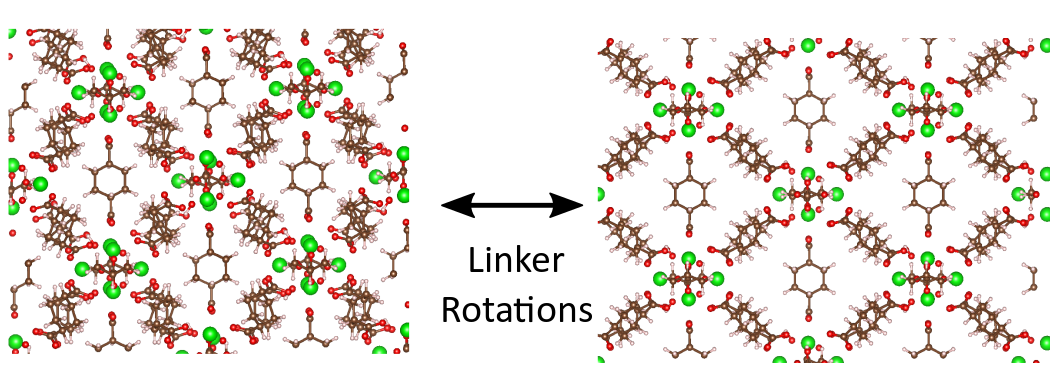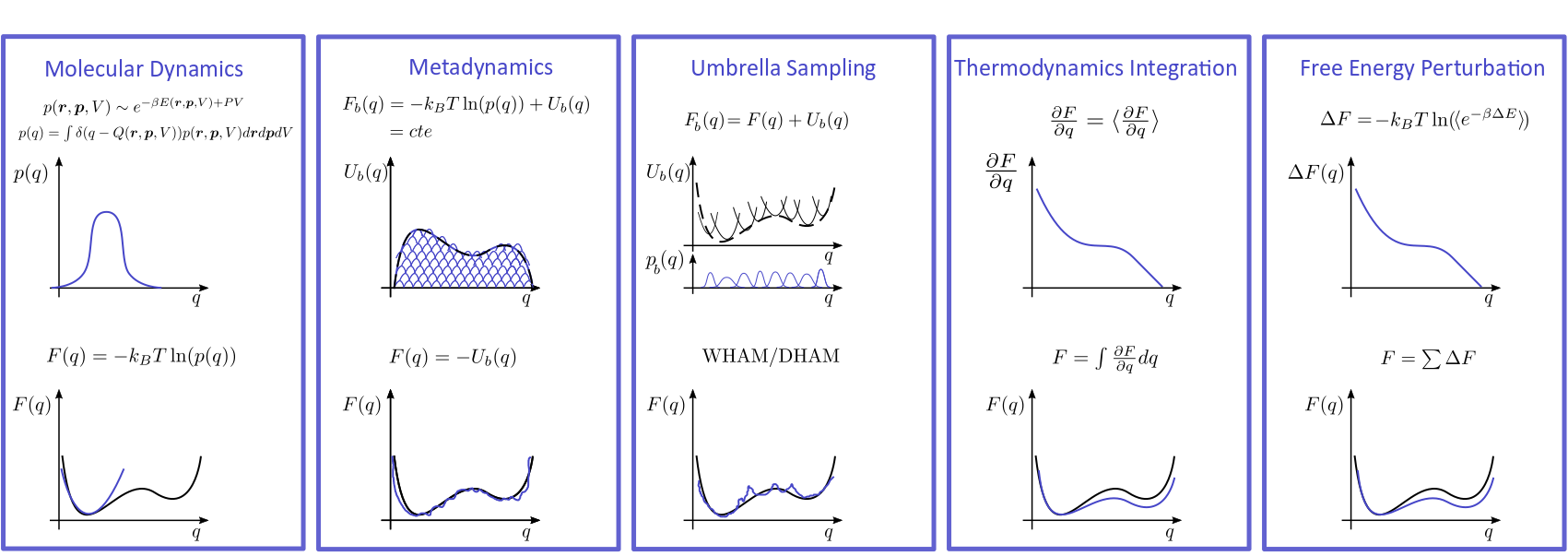Finding appropriate collective variables to describe phase transformations in flexible materials
Finding appropriate collective variables to describe phase transformations in flexible materials
Promotor(en): V. Van Speybroeck /16NANO07 / Nanoporous materialsNanoporous materials are omnipresent in a broad versatility of application domains such as energy storage, energy conversion, sustainable chemistry and biomedical applications. A special class of nanoporous materials are metal-organic frameworks (MOFs). These hybrid materials consist of metal-oxide clusters interconnected by means of organic linkers, resulting in a periodic framework with nanosized pores: a so-called nanoporous crystal. The discovery of MOFs therefore forms an important milestone in material science. Moreover, the enormous amount of linker/cluster combinations allow for tailor-made materials. Nevertheless, synthesizing all possible linker/cluster combinations would be an impossible endeavor. Model-guided design has therefore become indispensable in the development of new materials. At the Center for Molecular Modeling (CMM), computer simulations are applied to predict the thermodynamic behavior of MOFs and to guide the experimentalist towards desired applications.
A special property of some of these MOFs is their flexible behavior, i.e. their ability to undergo large-amplitude structural deformations under the influence of external stimuli. This special feature paves the way for a whole new range of applications such as nanosprings and nanodampers. Although very intriguing, these transitions are also very challenging to model computationally. The challenges are threefold. First, an accurate force field describing the energy variations observed during a transition need to be developed. Second, the atomic motions which drive the flexible behavior in complex MOFs–the so-called collective variables–need to be identified. Third, since these transitions may occur on a long time scale, advanced simulations need to be performed, based on the force field and obtained knowledge on the collective variables, to mimic the transition under study in a feasible simulation time. Recently, some new materials were discovered which show a very complex breathing behavior that is governed by flexible organic linkers. One of our experimental partners has recently synthesized materials with a cyclohexane linker (COK-69 and UiO-66-CDC [1]) that may twist, bend or screw, hence paving the way for diverse modes of flexibility. As an example, the phase transformation in UiO-66-CDC is shown in Figure 1. In the left pane, the closed-pore structure is indicated, which folds towards the large-pore structure in the right pane via linker rotations, and vice versa. A theoretical description of these phase transitions cannot be captured by a single collective variable, and a more advanced set of collective variables is needed to determine the free energy profile of the various phases, forming one of the pillars of this thesis subject.

Goal
The aim of this master thesis is to identify a well-chosen set of collective variables, which can then be used in advanced simulation techniques to steer the system towards interesting phases, and hence to construct accurate free energy profiles for variety of complex MOFs. The principles of statistical physics will be used to determine the macroscopic properties by following the time evolution of the system. This requires the choice of an appropriate Hamiltonian to describe the potential energy of the system. Ideally, this would be done using quantum mechanics. However, as the systems of interest are quite large and we need to sample for a sufficiently long time to get statistically adequate data, it is impossible to perform the molecular dynamics simulations using quantum mechanically based simulations. To circumvent this problem, the CMM has developed a force-field based engine, which describes the potential energy of the molecular system without explicitly considering the electronic structure of the material. Within this thesis subject, available force fields will be used.
Since the transitions under study are often rare events, and hence are usually not sampled in regular molecular dynamics simulations, enhanced sampling techniques such as metadynamics and umbrella sampling are required. These techniques, which have already been implemented in our in-house developed software package Yaff, are illustrated in Figure 2. However, key to the application of these techniques is an adequate choice of the collective variables. Due to the large number of degrees of freedom involved in the flexible MOFs, identifying those internal degrees of freedom that truly drive the transitions is far from a trivial task. During the master thesis, the student will work on identifying the collective variables for the materials recently synthesized by our experimental partner. As stated above, the breathing motions become highly complex due to the cyclohexane linker. In a first stage, the collective variables can be obtained from physical intuition. In a later stage, the student can apply statistical methods to identify those collective variables important for framework transitions. After obtaining a good set of collective variables, an accurate free energy profile as a function of these collective variables can be constructed, yielding vital information on the flexibility of the MOF.

The student will be actively coached to make him/her acquainted with the advanced simulations techniques early in the thesis year, and to transfer necessary programming skills needed to perform the research.
Engineering & Physics aspects
Physics: use of quantum and classical mechanical models for materials modeling
Engineering: engineering of materials for applications such as storage, separation, …
- Study programmeMaster of Science in Engineering Physics [EMPHYS], Master of Science in Physics and Astronomy [CMFYST]ClustersFor Engineering Physics students, this thesis is closely related to the cluster(s) MODELING, MATERIALS, NANOKeywordsmolecular simulations, Force fields, Free energy calculations, Nanoporous materialsReferences
[1] B. Bueken, F. Vermoortele, M. J. Cliffe, M. T. Wharmby, D. Foucher, J. Wieme, L. Vanduyfhuys, C. Martineau, N. Stock, F. Taulelle, V. Van Speybroeck, A. L. Goodwin en D. De Vos, „A breathing zirconium metal-organic framework with reversible loss of crystallinity by correlated nanodomain formation,” Chem.-Eur. J., vol. 22, nr. 10, pp. 3264-3267, 2016.


